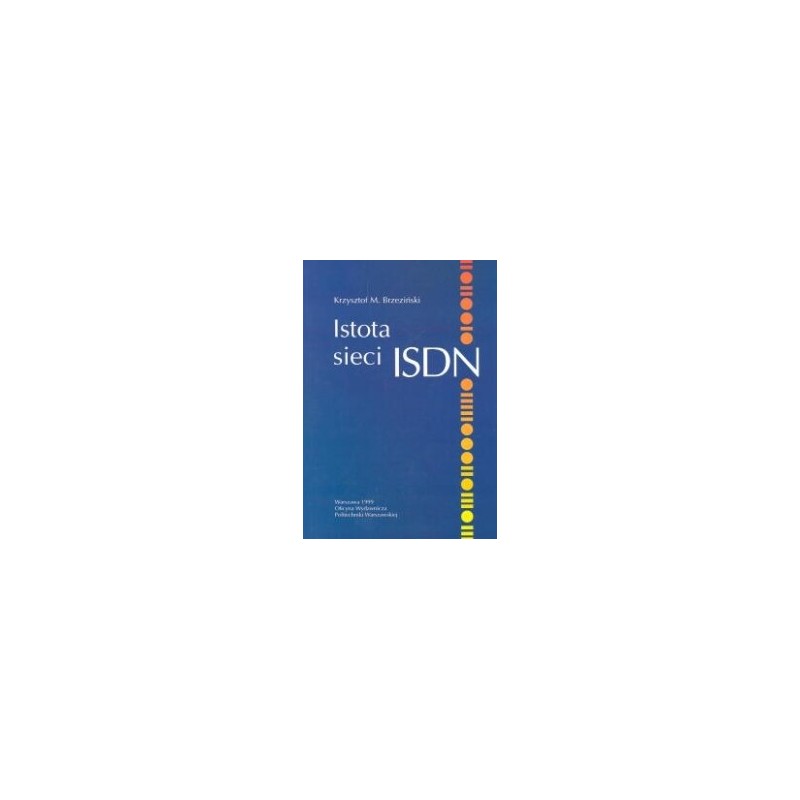- Out-of-Stock



Krzysztof M. Brzeziński
About the book
In Poland, in 1998, a modern, fully digital telecommunications network with the integration of ISDN services was launched. The task of this study is to present the conceptual, constructional, technological, service and utility issues of the ISDN network. The book discusses solutions used in a particular ISDN class class - in Euro-ISDN networks.
Table of Contents
PREFACE
Chapter 1
GENESIS AND TECHNICAL ASSUMPTIONS OF ISDN NETWORK
1.1. Introduction
1.2. Telecommunications system - general comments
1.3. The genesis of the ISDN network
Chapter 2
OVERVIEW OF THE ISSUES
2.1. Basic concepts
2.2. structures
2.3. Services
2.4. signaling
Chapter 3
LAYER 1: SIGNAL TRANSMISSION IN SUBSCRIPTION ACCESS
3.1. Introduction
3.2. Contact configuration
3.3. The structure of multiplication
3.4. Transmission coding
3.5. Organization of multiple access
3.6. Power
3.7. Contact activation
Chapter 4
LAYER 2 DSS1: SIGNAL LINK
4.1. Tasks and mechanisms of layer 2
4.2. Layer architecture
4.3. LAP-D protocol
4.4. The TEI ID management protocol
4.5. The implementation structure of layer 2
Chapter 5
LAYER 3 DSS1: SIGNALING FOR BASIC SERVICING OF APPLICATIONS
5.1. Protocol classes
5.2. Terminology
5.3. The use of lower DSS1 layers
5.4. Signaling procedures - sketch
5.5. Protocol syntax
5.6. Identification and selection of the basic service
Chapter 6
ADDITIONAL SERVICES
6.1. Service control
6.2. Generic protocols
6.3. MSN - Multiple Subscriber Number
6.4. TP - Terminal portability
6.5. CW - Pending call
6.6. CLIP / CLIR - Identification of the calling link
6.7. COLP / COLR - Identification of the link achieved
6.8. HOLD - Maintaining the connection
6.9. DDI - Direct dialing of the extension number
6.10. SUB - Subaddressing
6.11. Signaling between users
6.12. AOC - Information about the fee
6.13. Redirection services (CFx, CD)
6.14. MCID - identification of malicious calls
6.15. ECT - explicit transfer of the call
6.16. CCBS - connection setup after release
6.17. Family of conference services
6.18. The problem of interaction of services
Chapter 7
IMPLEMENTATION OF BASIC SERVICES
7.1. 3.1 kHz telephony
7.2. A group of audiovisual teleservices
7.3. Teleakcja
7.4. Telematic services
Chapter 8
VERIFYING THE IMPROVEMENT OF ISDN NETWORK
8.1. Introduction
8.2. Compliance in the life cycle of the protocol
8.3. Formulating requirements
8.4. Compliance tests
8.5. Integration tests
8.6. Verification methodology and the form of standards
8.7. Compliance testing technology
BIBLIOGRAPHY
ADDITIVES
A - Compliance testing methodology
B - Agreement on the implementation of the Euro-ISDN network
C - List of L3 DSS1 news and information components
D - An example of signaling progress
MARKINGS AND ABBREVIATIONS
INDEX
No product available!
Battery: Li-Po; 3.7V; 400mAh; Outputs: wires with 2-pin JST-PH connector; 5 x 25 x 35mm. PRT-10718
No product available!
No product available!
Printed circuit board and programmed AA / AAA cell capacity tester. AVT3169 A +
No product available!
The switch module has a relay with a control function via a WiFi network. It can be connected to a WiFi network or act as a stand-alone access point. Shelly 1 Open Source
No product available!
No product available!
No product available!
No product available!
No product available!
Camera with a resolution of 2 MPx with a USB interface. Equipped with CMOS IMX291 sensor with an ultra-wide 160° lens, two microphones, housing and a tripod. ArduCAM UB020202
No product available!
No product available!
ROSA3D filament made of high-quality PLA granules. 0.8 kg of filament with a diameter of 1.75 mm is wound on the spool. ROSA3D PLA Starter Apple Green
No product available!
AVT kit for self-assembly of the USB-1-Wire converter. AVT1787 B
No product available!
PCB Cleaner KT-5 is an effective and efficient preparation for cleaning printed circuits and electronic equipment, ideal for removing rosin and fluxes, offering safety for electromechanical, optical and electronic materials
No product available!
No product available!
No product available!

Krzysztof M. Brzeziński
